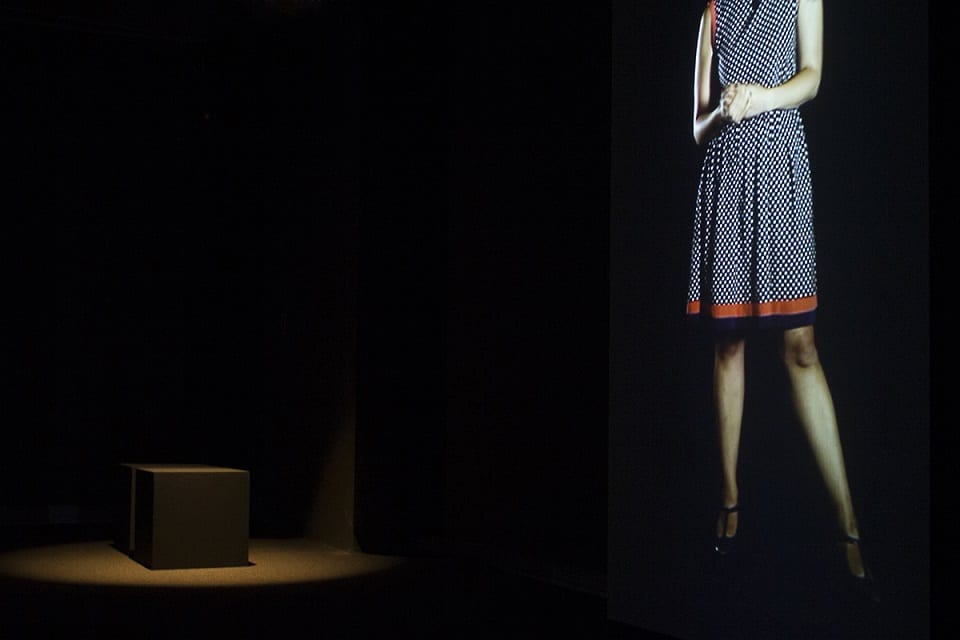Entering the space, audiences are subjected to multiple voices speaking at once – in unrecognisable languages – whilst blanketed by darkness. As the viewer’s eyes adjust, they are invited to edge towards a figure who speaks animatedly to no one in particular. Underneath a Perspex hood, one begins to focus on the filtered English translation as the anonymous speaker, framed within a flat screen monitor, recounts their story. Each narrative is different, yet as it becomes apparent when approaching each figure in turn, dishearteningly similar. Acting as a testament to a country rich with identitarian difference, these films are representative of Turkish populations beset by religious and sexual discrimination. Though the country has had a secular society since Atatürk abolished the Ottoman Empire and founded the Turkish Republic in 1923, artist Ipek Duben explains that “it is still fiercely traditional”, with the government advocating an Islamic “style of life” if not imploring for religious commitment from its citizens.
Acutely aware of the seemingly widening divisions within society, Fabrica Director Liz Whitehead brought the multi-screen film installation to the Brighton-based gallery after seeing it at SALT, Istanbul, struck by its resonance with issues closer to home. Originally, the work was presented in a central area identified with “the civic” – a forum for discussion upheld by Fabrica. Duben explains that she was “thrilled” that the piece was being shown in a deconsecrated church as it retains that context of community engagement, and in extension, deals with the positive and negative outcomes of organised religion. The capacity to represent issues in all their social and political complexity is characteristic of Duben, who refuses to offer simplistic resolution to conflicts, instead demonstrating how they are deeply embedded within both the exhibition space and the audience’s perceptions.
For example, Turkey featured prominently in the discourse which led to Brexit, a fact not lost on Duben, who recalls the frenzied tabloid proclamations that 20 million Turks were “heading to Europe” with dry distaste. In this context, the artist’s film What is a Turk (2004), which functions as something of an introduction to the exhibition at Fabrica, offers context to a history which is pertinent yet often overlooked. Exploring how European Orientalism positioned “the Turk” as its Other over an extended historical period, it was this film which encouraged and inspired the creation of the multi-screen video installation THEY/ONLAR, as it prompted Duben to think about who “the Other” within Turkish society might be.
This particular piece of work succeeds in both giving space to a specific sense of character discrimination with respect to gender, sexuality and ethnicity whilst illuminating both shared origins and differences. This may be a result of a lengthy gestation – ten years in the making – and because it reflects a greater depth of time through the many layers of recounted lives, all subjected to discrimination. The title THEY/ONLAR (“Onlar” translating to “they” in Turkish) offers a hint towards the conceptual message. Our understanding of identity, it shows, is shaped by the binary language that is used – self/other, man/woman – creating meaning by opposition. Demonstrating a breadth of cultural intersections through the plethora of voices, the installation enables viewers to reflect wholly upon the role of language in creating and sustaining prejudice but also the role it must play in finding common ground.
Laura Purseglove
Ipek Duben: THEY/ONLAR runs until 29 May at Fabrica Gallery, Brighton. For more information: www.fabrica.org.uk
For the latest in contemporary arts and culture, follow us on Instagram, Twitter and Facebook.
Credits:
1. Courtesy Pi Artworks Istanbul / London and Ipek Duben.





